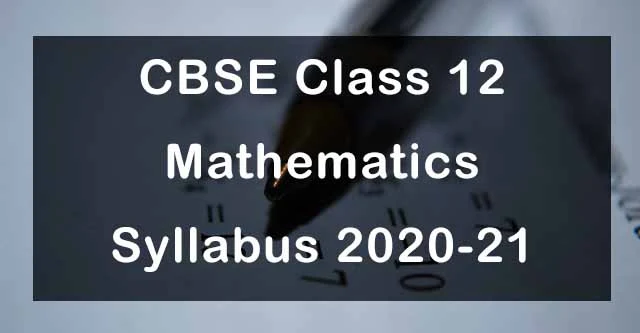CBSE Class 12 Maths Syllabus 2020-21| Check Latest Exam Pattern
CBSE has released Class 12 Maths Syllabus 2020-21 that are very useful in understanding the exam pattern and important topics. Due to ongoing health crisis, the board has also decided to remove some topics to ease the burden. The question paper will be of 80 marks while internal assessment will be given 20 marks.


S. No.
|
Units
|
Marks
|
| I | Relations and Functions | 08 |
| II | Algebra | 10 |
| III | Calculus | 35 |
| IV | Vectors and Three - Dimensional Geometry | 14 |
| V | Linear Programming | 05 |
| VI | Probability | 08 |
| - | Internal Assessment | 20 |
| Total | 100 |
Unit-I: Relations and Functions
1. Relations and Functions
Types of relations: reflexive, symmetric, transitive and equivalence relations. One to one and onto
functions.
2. Inverse Trigonometric Functions
Definition, range, domain, principal value branch.
Unit-II: Algebra
1. Matrices
2. Determinants
Determinant of a square matrix (up to 3 x 3 matrices), minors, co-factors and applications of determinants in finding the area of a triangle. Adjoint and inverse of a square matrix. solving system of linear equations in two or three variables (having unique solution) using inverse of a matrix.
Unit-III: Calculus
1. Continuity and Differentiability
Continuity and differentiability, derivative of composite functions, chain rule, derivative of inverse trigonometric functions, derivative of implicit functions. Concept of exponential and logarithmic functions.
Derivatives of logarithmic and exponential functions. Logarithmic differentiation, derivative of functions expressed in parametric forms. Second order derivatives.
2. Applications of Derivatives
Applications of derivatives: increasing/decreasing functions, tangents and normals, maxima and minima (first derivative test motivated geometrically and second derivative test given as a provable tool). Simple problems (that illustrate basic principles and understanding of the subject as well as reallife situations).
3. Integrals
Integration as inverse process of differentiation. Integration of a variety of functions by substitution, by partial fractions and by parts, Evaluation of simple integrals of the following types and problems based on them.

Fundamental Theorem of Calculus (without proof).Basic properties of definite integrals and evaluation of definite integrals.
4. Applications of the Integrals
Applications in finding the area under simple curves, especially lines, parabolas; area of circles /ellipses (in standard form only) (the region should be clearly identifiable).
5. Differential Equations

Unit-IV: Vectors and Three-Dimensional Geometry
1. Vectors
Vectors and scalars, magnitude and direction of a vector. Direction cosines and direction ratios of a vector. Types of vectors (equal, unit, zero, parallel and collinear vectors), position vector of a point, negative of a vector, components of a vector, addition of vectors, multiplication of a vector by a scalar, position vector of a point dividing a line segment in a given ratio. Definition, Geometrical Interpretation, properties and application of scalar (dot) product of vectors, vector (cross) product of vectors.
2. Three - dimensional Geometry
Direction cosines and direction ratios of a line joining two points. Cartesian equation and vector equation of a line, coplanar and skew lines, shortest distance between two lines. Cartesian and vector equation of a plane. Distance of a point from a plane.
Unit-V: Linear Programming
1. Linear Programming
Introduction, related terminology such as constraints, objective function, optimization, different types of linear programming (L.P.) problems. graphical method of solution for problems in two variables, feasible and infeasible regions (bounded), feasible and infeasible solutions, optimal feasible solutions (up to three non-trivial constraints).
Unit-VI: Probability
1. Probability
Conditional probability, multiplication theorem on probability, independent events, total probability, Bayes’ theorem, Random variable and its probability distribution.
Prescribed Books:
• Mathematics Part I - Textbook for Class XII, NCERT Publication
• Mathematics Part II - Textbook for Class XII, NCERT Publication
• Mathematics Exemplar Problem for Class XII, Published by NCERT
• Mathematics Lab Manual class XII, published by NCERT
| Internal Assessment | 20 Marks |
| Periodic Tests ( Best 2 out of 3 tests conducted) | 10 Marks |
| Mathematics Activities | 10 Marks |
Note: For activities NCERT Lab Manual may be referred.
Download Class 12 Maths Syllabus 2020-21
Download Class 12 Maths Syllabus 2020-21

